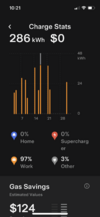I am keeping monthly tabs on how much the Tesla vehicle says I used in the trip odometer vs what the chargepoint monthy stats shows.
For the month of November, I used 300 miles or range. Tesla shows that I averaged 265 Wh/mile. Using charge point it shows I charged up 112 kWh for the entire month.
if I divide 112,000 to 300 i get 373 Wh/mile.
Is the big difference because of the loss energy when charging up a vehicle or is Tesla not showing the true amount?
You have a 2022 Performance. Unfortunately even though you say you used 300 miles of range in November, we can't say how much energy you used. If you used that only while driving (most likely not the case, but I don't know how you arrived at this number), that would mean you used:
300rmi * (80.6kWh/315rmi) *0.955 = 73.3kWh.
And you traveled 73.3kWh/265Wh/mi = 277 miles.
But really it would be better to specify how many miles you traveled in November so we can get the actual correct values here.
But in any case, what people said:
1) Rated miles decay even when parked so don't represent how many you used while driving.
2) Trip meter shows energy used only while driving but you didn't specify how far you drove so we can't determine how much energy you used.
3) The energy used at Chargepoint is hard to use here because to use it to compare you have to assume that you started and ended the month at exactly the same SOC (otherwise you might be counting energy used that is still in your pack, or similarly, not counting energy that you used that you still need to replace).
4) Energy used at Chargepoint includes charging losses, and also it will reflect other losses that occurred while parked that have to be added back to the pack, and these can be significant. Adding 20-50% on top of the trip meter is generally reasonable to estimate wall-to-wheels efficiency, but it's a huge range depending on conditions, charging setup, feature usage, etc.
5) The 373Wh/mi is not correct because you divided by rated miles, not miles.
Anyway if we went with the 277miles traveled (probably wrong), that would work out to 404Wh/mi, but see other caveats above about starting/ending SOC in month.



